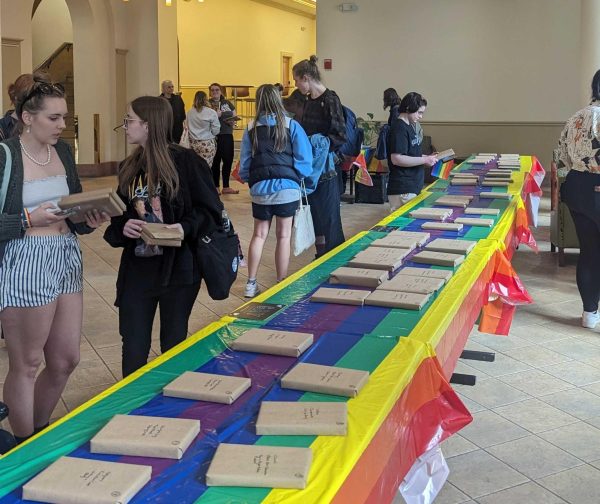Gina Catanzarite: A Modern Village Storyteller
April 4, 2017
Throughout the duration of Gina Catanzarite’s flourishing career, there are many stories she has transcribed into award-winning documentaries; one in particular made a lasting impression.
She documented an organization called “Project Hope” when they welcomed 30 prospective Russian adoptees to the greater Pittsburgh area in hopes of finding them a new home.
Yuri, one of the hopefuls, curled up in the bus, crying and lamenting, as they returned to Russia, knowing he was the only child permanently returning to the orphanage.
Gina Catanzarite offers voice to the people that don’t have one; she converts the unspoken intimacies of common human life into renowned documentaries, and passionately teaches students the inner-workings of the broadcasting world.
“Before I had the ability to write, I was a storyteller,” Catanzarite said.
Catanzarite began her career directly after graduating from the University of Pittsburgh in 1987 with degrees in non-fiction writing, film theory and a certificate in American Sign Language for the Deaf. She began working at KDKA as a copywriter and mainly focused on entertainment stories, but her analytical abilities eventually lead her to pursue a master’s degree in Journalism Education from Kent State University later in life.
At just seven years old, she was deeply imprinted by the teachings of Charlotte’s Web, which stresses the importance of being a true friend and a good writer. It inspired her to shift from imitating stories through Barbies to writing it down on paper. She now has her own company called Arania Productions, named after one of Charlotte’s little spiders.
“I asked my dad to take me to the drugstore, I bought my first tablet and I used it as a diary,” Gina Catanzarite said. “I’ve had a diary every day ever since then.”
As her career advanced she realized there was an internal drive to travel more and began looking for jobs in Los Angeles. She was offered a job as a head assistant in an LA studio and planned on moving out there in August of that year.
On the night of her 26th birthday, she was laying in the bathtub reading a magazine and noticed the right side of her body was uneven compared to the left. The next day, during her regular check-up, she casually mentioned it to her doctor. After a short and rushed examination, the doctor left the room. Catanzarite heard her frantically conversing with her co-workers about a possible tumor.
“We need to schedule an emergency sonogram,” the doctor said.
Ten days and an emergency surgery later, Catanzarite was left tumorless, 8 pounds lighter, but unable to move to Los Angeles for her new job. Throughout the next six years, she endured a long battle of ovarian cancer that grew wherever cuts from previous surgeries were incised. What some might call misfortune, she calls fate.
Catanzarite prolonged the rehabilitation process because she was trying to have kids, despite the inevitable difficulties. In 1997, at a run-of-the-mill six-month checkup, the doctors discovered the cancer had spread to her left fallopian tube. She knew in that moment her dreams of kids were to be pushed aside or else it might end fatally, without an opportunity to even receive children from an external source.
“Like the job in Los Angeles, and the imaginary baby I didn’t give birth to, things have a way of working themselves out,” Catanzarite said.
Since the final surgery, Catanzarite has been cancer-free. This doesn’t inhibit her from the constant worry of it coming back as it has many times before.
“After you have a really big illness, you never again have a hang-nail. It’s always an eight pound tumor in your pinky that you didn’t notice,” Catanzarite said.
In 1999, after her grieving period, Catanzarite decided she was going to adopt a child from a remote town in Russia known as Kalmykia. Throughout the entire process she was under the impression that her son’s name was Sasha. Ten days before she left to pick him up, she received a phone call from the adoption agency, explaining to her that due to a processing error, the assistant accidentally processed the wrong baby, the baby she—unexpectedly—would now be receiving.
“And once again you think your life is guided by this unbelievable being, and it’s a clerical worker who grabbed the wrong folder,” Catanzarite said.
Through the displacement caused by her utter dismay, Catanzarite wheedled her way into adopting both of the children, Sasha and Nikita, who ended up being first cousins. She laughed, looking back on that moment, wondering what in God’s name she was thinking.
Catanzarite documented the entire process in a video diary titled “Gina’s Adoption,” which won her the most personally-impactful Emmy out of the nine she has been awarded.
“It seemed crazy, this maelstrom while it was happening, now I could look backward and it looks like a straight line to the boys that I have,” Catanzarite said.
Her sons are both eighteen, and Sasha plans to follow in his mother’s footsteps by committing to Point Park University for a degree in broadcast journalism. Nikita has yet to converge on one of his many college offers but plans to study mathematics and political science.
Two years after the adoption story, Catanzarite produced a 3-part documentary series about a local Pittsburgh organization called “Project Hope.” They brought 30 Russian children ages 5-13 to Pittsburgh in hopes of finding them a family. The children spent the summer being introduced to the families, and all but one of them were welcomed into a new home.
Through much internal debate about how ethically sound it was to film a child experiencing extreme pain, Catanzarite decided to film him on the way back to the Dulles airport. As they neared he curled up in the seat and cried knowing he was the only one who wouldn’t be returning.
“It’s not easy because you are wading into people’s lives frequently at their hardest moments, and you have to make a lot of decisions about how to tell their story,” Catanzarite said.
The documentary was revered, won a Matrix Award in 2002 and was a finalist for a regional Emmy. It was re-aired on Christmas Eve of that year. Minutes before midnight, Catanzarite received a call from a couple who had watched the documentary and called QED immediately after. They were searching for the number of the adoption agency.
“That’s our son, isn’t it?” The now adopted mother of the boy, Yuri, said to her husband that night.
Catanzarite arrived at the couple’s house months later to complete a follow-up story about the family and when Yuri saw her and began to cry, ran up to his room and locked himself inside.
It wasn’t until later in life that she decided to educate young journalists. She was originally asked to teach a copy-writing class at Robert Morris University, eventually leading her to stay there until 2013 and at Point Park University, where she currently teaches broadcasting classes. She received her master’s degree online for journalism education at Kent State University, totaling her work load at that point to be between 80-90 hours a week.
Catanzarite prefers to run her classrooms in a flipped teaching style, where the students do their reading and busy-work at home, so the class period focuses mainly on the advancement of writing through her guidance.
Michael Stinelli, a student at Point Park, is in Catanzarite’s broadcast writing and editing class and her introduction to broadcasting class; he purposely chose her based off of a three-week trial he had with her during the last semester. He feels as though she has a tangible passion for not only journalism, but teaching it.
“She’s not afraid to tell you what you’re doing wrong and tell you loudly and explicitly,” Stinelli said. “Everyone needs to figure out what they’re doing wrong to get better.”
Through many minor bangs on the table, a raised voice and an inability to clearly glimpse Catanzarite because she is never standing still, it is evident that she pushes her students to success. She runs back-and-forth to each student to ensure they are writing properly, and although she publicly declares the steps a student needs to make to get back on the right track, there is no condescension, and her students clearly understand that. She defies the standards of schooling while still maintaining a focused, engaged classroom.
With a laundry list of awards for the detailed work Gina Catanzarite has completed, the one’s that mean the most are what’s left a visible footprint somewhere else in this world, like her documentary “The Race to Save Pennsylvania’s Bats” which is used to educate rangers all around the country, or her documentary “Human Trafficking: Pittsburgh Fights Back” which is used as a training video for the FBI.
Since she was seven years old, she wanted to tell stories and has. She has become a translator for the forgotten and highlights the inherent good and bad in all humans, whether it be a hard-working woman stereotyped to be undeserving of welfare, or a 24-year-old brain cancer patient laughing through the terminal illness.
“You really leave rooting for people. You see the depth and breadth of people’s struggles,” Catanzarite said. “Very few people are all good or all bad.”
As a TV Producer, writer, teacher, parent and media consultant, there is never free-time for Catanzarite, clocking in somewhere over 75 hours a week of work. Although her stress levels soar to new heights each day and she has a hard time encumbering the weapons-grade anxiety that comes with the territory. She preserves a calm demeanor that carries her effortlessly through her days where she only has enough time for cereal and coffee.
“If there is any coping strategy it’s making peace with the fact that if that’s the choice in what you’re doing at the moment, then be there 100%,” Catanzarite said.
Throughout all of Catanzarite’s national and international escapades, there is one moment above all that was her favorite: watching the sunrise with her six-year-old boys with donuts and coffee on the beach of Ocean City, New Jersey as the rest of the world began to wake up.












